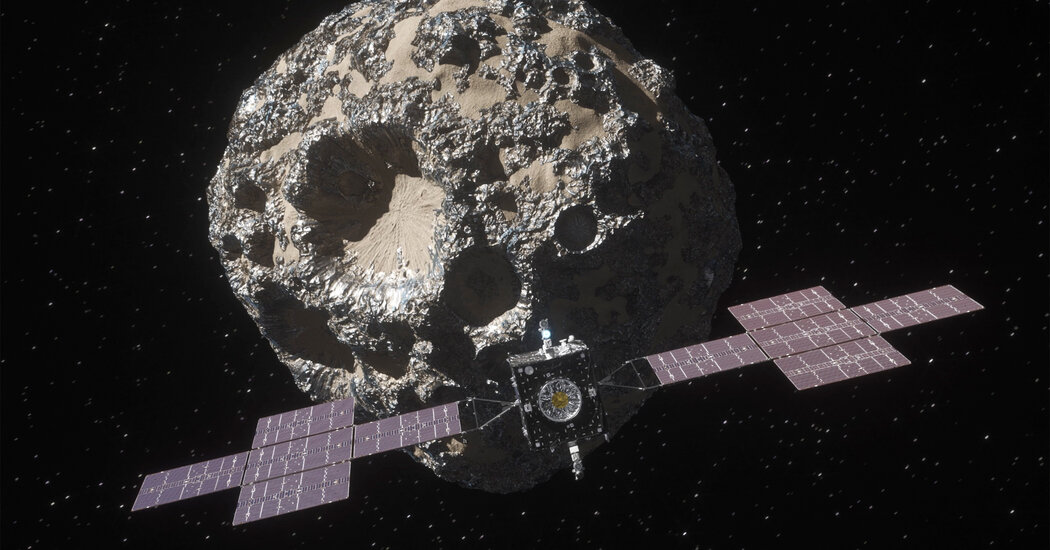For generations, Western space missions have largely occurred out in the open. We knew where they were going, why they were going there and what they planned to do. But the world is on the verge of a new era in which private interests override such openness, with big money potentially on the line.
Sometime in the coming year, a spacecraft from AstroForge, an American asteroid-mining firm, may be launched on a mission to a rocky object near Earth’s orbit. If successful, it will be the first wholly commercial deep-space mission beyond the moon. AstroForge, however, is keeping its target asteroid secret.
The secret space-rock mission is the latest in an emerging trend that astronomers and other experts do not welcome: commercial space missions conducted covertly. Such missions highlight gaps in the regulation of spaceflight as well as concerns about whether exploring the cosmos will continue to benefit all humankind.
“I’m very much not in favor of having stuff swirling around the inner solar system without anyone knowing where it is,” said Jonathan McDowell, an astronomer at the Harvard-Smithsonian Center for Astrophysics in Massachusetts. “It seems like a bad precedent to set.”
But for AstroForge, the calculation is simple: If it reveals the destination, a competitor may grab the asteroid’s valuable metals for itself.
“Announcing which asteroid we are targeting opens up risk that another entity could seize that asteroid,” said Matt Gialich, AstroForge’s chief executive.
☄️☄️
Asteroid mining entered into the doldrums in recent years after two startups proposing to prospect the solar system went out of business in the late 2010s. But now several companies in the United States, Europe and China are taking another stab at the endeavor. Even a congressional committee held a hearing on the subject in December.
The renaissance is sparked by a new wave of commercial space exploration, driven largely by SpaceX, the company founded by Elon Musk that flies reusable rocket boosters and has reduced the cost of reaching space.
With that increased activity is also increasing secrecy.
In 2019, the Israeli-built commercial Beresheet lander tried to land on the Moon but crash landed. On board, kept secret until after the failed landing, were a few thousand tardigrades, microscopic animals supplied by the nonprofit Arch Mission Foundation. The crash raised concerns about potentially contaminating the moon with the hearty creatures and led to an investigation by the Federal Aviation Administration.
More recently, the suborbital spaceflight firm Virgin Galactic has withheld the identities of the people on board its space plane until after the missions are completed, a practice not seen before with human spaceflight. And some satellites hitching rides to space with lots of other orbital craft, in what are known as rideshare missions, have also been kept secret.
“We’re seeing frequent launches where we don’t know what the satellites are that were deployed until some time afterwards,” said Dr. McDowell, who maintains a public database of spacecraft in orbit.
For missions beyond Earth, there are no legal restrictions against keeping a deep space mission’s destination secret as AstroForge intends to do, said Michelle Hanlon, a law professor specializing in space at the University of Mississippi.
“We don’t have an actual process for deep-space missions like this,” she said, because “there is no licensing process” in the United States.
But complex issues could arise if, for example, multiple asteroid miners arrived at the same asteroid.
“There needs to be some kind of transparency here,” Dr. McDowell said. He noted that while there was a United Nations requirement for space agencies and companies to reveal their orbits and trajectories in space, “it’s usually ignored for solar orbit objects.”
The lack of penalties, he added, “should spark discussion among regulators.”
☄️☄️☄️
AstroForge’s mission, Odin, would be the second spacecraft it has sent to space. Its first in April, Brokkr-1, was a microwave-size machine weighing about 25 pounds. The goal of that mission was to practice refining metals in the environment of space. The spacecraft has encountered problems, however, the company said on Dec. 11. AstroForge is in a “race against time” to get Brokkr-1 working before it is lost.
Odin, on the other hand, weighs a much heftier 220 pounds. AstroForge plans for it to piggyback on a robotic mission to the moon in 2024 by the company Intuitive Machines that is sponsored by NASA and being launched on a SpaceX Falcon 9 rocket. A launch date has not yet been set.
During the journey to the moon, the plan is for Odin to be released and to venture into deep space beyond lunar orbit. Within a year, according to AstroForge, the spacecraft will fly past the mystery asteroid, taking pictures in the process and looking for evidence of metal.
AstroForge is aiming for what is suspected to be an M-type asteroid. These are thought to be fragmented pieces of failed planetary cores and may be rich in valuable platinum-group metals, which have a wide range of uses including in health care and jewelry.
No spacecraft has ever visited such an asteroid before, although NASA’s Psyche mission, launched in October, is on a mission to a potential M-type asteroid, also named Psyche, between Mars and Jupiter. It will not arrive until August 2029, however, affording AstroForge a chance to be the first to visit such an object.
So far AstroForge has raised $13 million from investors. A full mining mission would require a much larger investment. But there are riches to be made if the company is successful. On Earth, the metals that may be on M-type asteroids can be difficult and expensive to mine. Iridium, for example, sells for thousands of dollars per ounce.
The business case for grabbing metals from asteroids has not always been so clear. It is difficult and costly to return material to Earth; NASA’s OSIRIS-REx mission returned only an estimated half a pound of material from an asteroid called Bennu in September at a cost of an estimated $1.16 billion.
AstroForge is confident in its financial prospects. “We expect that we can return materials at a high margin,” Mr. Gialich said. “We created our business model by leveraging ride shares and partnerships to make each mission as economically viable as possible.”
Akbar Whizin, a planetary scientist at the Southwest Research Institute, said he understood the motivation to keep the asteroid a secret. He formerly worked for Planetary Resources, a mining startup that never reached any asteroids, and it, too, was coy about its targets.
“This is a commercial enterprise,” he said. “You wouldn’t go telling people, ‘I know where the gold is.’”
But some scientists think asteroid miners should be more forthcoming about what they seek. M-type asteroids give humanity a window into the chaotic early solar system 4.5 billion years ago, when objects frequently smashed together and the planets were born. That means anything AstroForge discovers could be scientifically valuable, said Stephanie Jarmak, a planetary scientist also at the Harvard-Smithsonian Center for Astrophysics.
“I’m a pretty big proponent for open science,” said Dr. Jarmak, also the project scientist for NASA Science Explorer. “We haven’t visited an M-type asteroid before, so there’s quite a bit we can learn.”
That could include “insights into the heating processes that were going on early in solar-system history,” said Andy Rivkin, an astronomer at the Johns Hopkins University Applied Physics Laboratory who led NASA’s DART mission to impact an asteroid in September 2022.
“We will never get to Earth’s core,” he said. “So visiting these kinds of objects will give us information that we could extrapolate to learn more about Earth and apply that to different planets.”
Benjamin Weiss, a planetary scientist at the Massachusetts Institute of Technology and the deputy principal investigator on the Psyche mission, said the true nature of M-type asteroids was still unclear. While it had “always been the leading assumption” that M-type asteroids were metallic, he said, we did not know for certain.
In 2010, the European Space Agency’s Rosetta spacecraft flew past the asteroid Lutetia. Scientists discovered that it was not as metallic as suspected. That would make anything AstroForge discovered all the more worthwhile, Dr. Weiss said.
Mr. Gialich said AstroForge would be transparent, except about the asteroid itself. “We are not keeping our mission secret,” he said. “We plan to share the images.”
☄️☄️☄️☄️
While AstroForge is not revealing its target asteroid, it might be possible to work out where the company is going.
There are about 30,000 asteroids known to be near Earth, giving AstroForge many potential targets. But the company has said that its target is less than 330 feet in size, and reachable within a year of the launch. That means it must cross or at least pass near to Earth’s orbit. The asteroid is also suspected to be an M-type, which are brighter than other asteroids because of their potential metal content.
According to Mitch Hunter-Scullion, chief executive of the Asteroid Mining Corporation, a potential AstroForge competitor in Britain, these clues narrow down the list of potential targets to “approximately 300 asteroids.”
Dr. Jarmak refined the potential targets even further, accounting for brightness and size. “We have a list of 14 objects,” she said.
Of those, particularly promising is 2010 CD55, which is about 270 feet across, reasonably bright — hinting at metallic content — and reachable from Earth in the time frame of AstroForge’s launch date.
Mr. Gialich would not verify or deny that suggestion.
“We do not want to publicly confirm our target asteroid,” he said.
He added that there were multiple targets AstroForge was considering. “We are actively tracking several asteroids that would be viable for our Odin mission should our launch date slip,” he said.
Even if the asteroid cannot be identified before the launch, Dr. McDowell noted that it might be possible for amateur astronomers on Earth to track the spacecraft after it gets to space and work out where it is going.
“There are some practical issues,” he said. “But I certainly think there will be interest in tracking it.”



